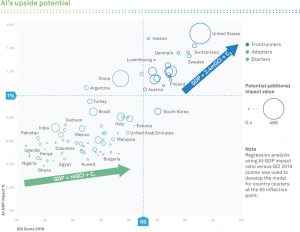Intelligent Connectivity Is the Catalyst for Fresh GDP Growth, According to Huawei Global Connectivity Index 2019 Report

As AI-infused Intelligent Connectivity begins to have a meaningful impact on the digital economy and sparks a tipping point for digital transformation, a key finding of Huawei’s GCI 2019 is that countries with GCI scores over 65 that have made continuous investment in Intelligent Connectivity can expect it to boost GDP by more than 1%. At the same time, success in the era of intelligence depends on the ability to collaborate on a global scale.
Now in its sixth year, GCI 2019 highlights AI’s role as one of four key enablers that drive “Intelligent Connectivity”, alongside Broadband, Cloud, and IoT. All four have the potential to be significant catalysts for economic growth.
A new tipping point for national digital transformation

The upside potential of AI can stimulate economic growthIn 2016, the GCI identified the inflection point for emerging markets. When a country scores 35 points in the index, it crosses the threshold beyond which there is a multiplier effect of GDP growth against ICT investment. GCI 2019 found that the stimulus effect of the inflection point was giving a bump to countries on the top of the GCI S-curve as well. For countries with a GCI score of over 65, the S-curve starts to steepen once again. These countries are moving into a new growth cycle. Countries with the highest GCI scores can leverage Intelligent Connectivity to accelerate economic growth up to 2.4 times faster than other nations for every point of GCI improvement.
It is not just developed economies that can benefit from Intelligent Connectivity. GCI 2019 finds that nations at every level of digital development can access the “upside potential of AI” as a GDP booster when it is deployed by industries and organizations.
Even for Frontrunners like Japan and the US that have leading ICT infrastructure, the potential of AI has only just begun to be tapped. Adopters and Starters like China, Malaysia, India, the Philippines, and Spain aren’t spinning their wheels, either. They’re rolling out AI technologies as fast as they can.

GCI 2019 also identifies another way that Starter and Adopter nations can stimulate greater economic success: global collaboration. Because Intelligent Connectivity relies on global ecosystems to flourish, GCI 2019 identifies five stakeholder roles that can collaborate across domains to break down organizational silos and deliver fast business results: Decision Makers, Data Scientists, Data Collectors, ICT Companies, and End Users.Powering Intelligent Connectivity with global collaboration
Whatever a country’s level of digital development, policymakers need to look objectively at the strengths of their national economy and determine how they can fit into and profit from the Intelligent Connectivity ecosystem.
“We’re now seeing that the fusion of 5G, AI, and cloud has redefined connectivity,” said Kevin Zhang, the CMO of Huawei ICT Infrastructure Kevin Zhang. “Intelligent Connectivity is speeding up the development of the digital economy, so governments and industry leaders in Starter and Adopter nations should embrace new technologies, prioritize work on national-level digital transformation plans, and benefit from global collaboration. Meanwhile, we’ve realized that Intelligent Connectivity may be the answer to many of the societies’ most complicated and deeply rooted challenges, including climate change and the wealth gap between rich and poor. Huawei is committed to increasing efforts to make technology, applications, and skills accessible to everyone, and bringing Intelligent Connectivity’s benefits to every person, home and organization.”
The GCI is designed to provide actionable insights for how policy makers and economic stakeholders can foster greater success in the digital economy. The 79 countries assessed by GCI 2019 account for 95 percent of global GDP and 84 percent of the world’s population.
For more on the Global Connectivity Index 2019, visit: http://www.huawei.com/minisite/gci/en/
–ends—
About Huawei
Huawei is a leading global provider of information and communications technology (ICT) infrastructure and smart devices. With integrated solutions across four key domains – telecom networks, IT, smart devices, and cloud services – we are committed to bringing digital to every person, home and organization for a fully connected, intelligent world.
Huawei’s end-to-end portfolio of products, solutions and services are both competitive and secure. Through open collaboration with ecosystem partners, we create lasting value for our customers, working to empower people, enrich home life, and inspire innovation in organizations of all shapes and sizes.
At Huawei, innovation focuses on customer needs. We invest heavily in basic research, concentrating on technological breakthroughs that drive the world forward. We have more than 188,000 employees by the end of 2018, and we operate in more than 170 countries and regions. Founded in 1987, Huawei is a private company fully owned by its employees.
For more information, please visit Huawei online at www.huawei.com or follow us on:
http://www.linkedin.com/company/Huawei
http://www.facebook.com/Huawei
Disclaimer: The story is in the form of a Press Release and has not been edited or reviewed for language or content. The content is published in the form that it was received by the editors after removing certain personal information such as contact numbers and emails. CXOToday.com is not responsible for the veracity of this content







